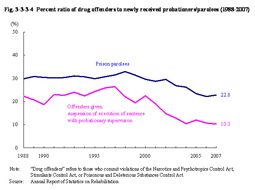| Previous Next Index Image Index Year Selection | |
|
|
4 Probation / parole supervision The ratio of prison parolees has been on a declining trend since 1999, and that of offenders given suspension of execution of sentence with probationary supervision has been on the same trend since 2001. In the categorized treatment system (see Part 2, Chapter 5, Section 2, 2 (5)), drug offenders are classified into “stimulant drug offenders” and “abusers of thinner, etc.” and efforts to provide effective treatment for them are made through group treatment for probationers/parolees and lectures for their guardians and guarantors, etc. For prison parolees and offenders given suspension of execution of sentence with probationary supervision for stimulant drug offenses, treatment utilizing simplified urine tests (referred to as “simplified drug detection tests” since April 2008) based upon their voluntary willingness to participate in them started in April 2004. In 2007 8,616 tests were conducted for 3,644 prison parolees and offenders given suspension of execution of sentence with probationary supervision (Source: The Rehabilitation Bureau, Ministry of Justice). In addition, and in accordance with the Rehabilitation Act, probationers and parolees who meet certain conditions such as those whose offenses include stimulant abuse, etc. are obliged to take part in the “stimulants offenders treatment program” as a special condition of their supervision (see Part 2, Chapter 5, Section 2, 2 (2)). The program is a specialized treatment program consisting of simplified drug detection tests with the aim of strengthening and sustaining the willpower of offenders to stop using stimulants and education courses with the main aim of getting them learn concrete methods of preventing relapses. During the program, they are obliged to take simplified the drug detection tests in parallel with the education courses. Fig. 3-3-3-4 Percent ratio of drug offenders to newly received probationers/parolees (1988–2007) |
